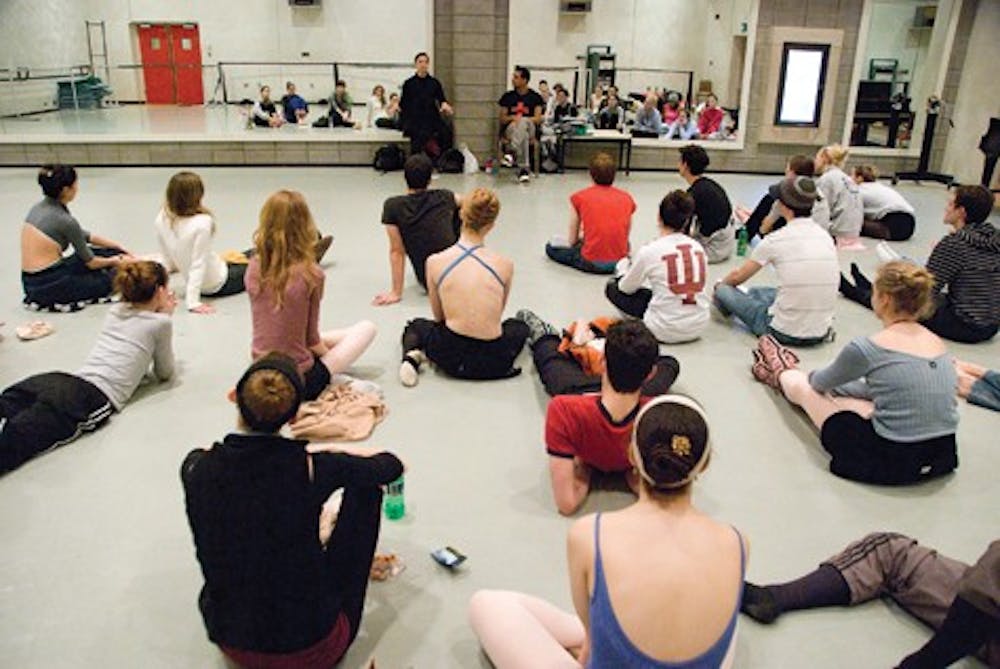Sweat rolled down the faces of the dancers, during Complexions Contemporary Ballet’s master class at the Musical Arts Center on Monday, as they learned a routine at a fast-paced rate from company member Juan Antonio Rodriguez.\nRodriguez, a five-year company member, used ballet terms to express the choreography, instead of counts.\n“Many dancers are used to hearing ‘5,6,7,8.’ Instead you are hearing ‘plie, ronde de jambe, fourth,’ which adds a new element of dancing to those who have never experienced it,” freshman Angelica Harbour said.\nThe lecture and master class, hosted by Union Board and the Jacobs School of Music Ballet Department, was designed to inspire students to think outside the box, pushing the envelope of contemporary ballet.\n“Complexions is important because their combination of ballet and modern is unusual,” said Michael Vernon, chair of the ballet department. \nVernon said the Complexions director, Dwight Roden, has gone out on a limb using his background in ballet and modern dance to pursue where contemporary ballet will go in the future. \n“The idea to bring (Complexions) here was Michael Vernon’s, who is very familiar with New York ballet companies,” said Alexa Lopez, performing arts director for Union Board. “The event also falls into ArtsWeek’s ‘Politics and the Arts’ because Complexions are known for their body politics.”\nNew York City-based Complexions has been touring since 1995. On its Web site, it claims it is the original multi-ethnic dance company. \nHarbour, who has trained with several dance companies, including Deeply Rooted Productions’ summer intensive workshops, said Rodriguez’s style of teaching was similar to how she was taught at her predominantly black performing arts high school. \n“You’ll find different ways that all teachers of all genres of dance teach, but not counting out the steps is definitely part of the black dance aesthetics,” Harbour said.\nCounting was also discussed in the lecture that followed the master class.\n“We rarely use counts when learning a dance,” said Clifford C. Williams, one of two company members presenting the lecture. \nThe history of the company, the choreographic process and the dancers’ experience were all parts of the lecture. \n“The studio process always starts the same,” said Kimi Nikaidoh, a company member. “We do a bunch of steps, but the process outside the studio always differs.” \nNikaidoh said Roden is known as a deconstructuralist to the company. \n“He’s constantly putting things together and breaking them apart,” Nikaidoh said. “You’ll rarely see the same ballet twice based on this fact and the fact the dancers interpret the movement differently.” \nNikaidoh and Williams said the process of putting together a performance can be nerve-wracking, but it always looks great at the end. \n“There’s always a discrepancy about what the movement really is,” laughed Williams. \nWilliams said Roden and Desmond Richardson, another dancer with the company, met at Alvin Ailey American Dance Theater and had a common vision for sharing their appreciation for diversity and multiculturalism through dance. They thought bringing many artists from various disciplines into one room would allow their interactions to be a catalyst for ground-breaking and envelope-pushing creativity. \nComplexions’ performance scheduled for Monday night was canceled because of low tickets sales. However, the company performed twice in Indianapolis last week.
‘Complexions’ explores future of contemporary dance
Master class, lecture focus on diversity

Get stories like this in your inbox
Subscribe





